Sort by:


Exotic Giant Allium Multicolor Flower Garden Seeds
Exotic Giant Allium Multicolor Flower Garden Seeds
Allium Seeds
Characteristics and Uses of Allium Plants
The Allium Seeds from Dhara Seeds produce a stunning array of flowering plants known for their unique globe-shaped blooms and striking foliage. Alliums, commonly referred to as ornamental onions, are celebrated for their vibrant purple, blue, and white flowers that add a dramatic flair to gardens. These hardy perennials are not only visually appealing but also attract pollinators such as bees and butterflies, making them a valuable addition to any garden. With a commitment to quality, Dhara Seeds offers these non-GMO seeds to ensure you cultivate healthy and beautiful Allium plants.
Growing Conditions for Allium Plants
- Light Requirements: Full sun
- Soil Type: Well-draining, sandy or loamy soil
- pH Level: Neutral to slightly alkaline (6.5 - 7.5)
- Temperature: Prefers moderate temperatures, ideally between 60°F to 75°F
Planting Tips for Allium
- Seed Depth: Plant seeds about 1 inch deep
- Spacing: Space seeds 6-12 inches apart to allow for optimal growth
- Timing: Best planted in fall or early spring
Watering Instructions and Tips
- Watering Frequency: Water thoroughly after planting and allow the soil to dry out between waterings
- Watering Method: Water at the base of the plant to avoid wetting the foliage
- Drainage: Ensure proper drainage to prevent bulb rot
Growing Zones
Allium plants thrive in USDA zones 3-9 and are suitable for global growing zones that experience similar temperate climates. This adaptability makes them a great choice for various gardening environments.
Key Benefits & Uses
- Attractive Blooms: Adds color and interest to gardens
- Pollinator Friendly: Attracts beneficial insects
- Low Maintenance: Requires minimal care once established
Best Uses in the Garden & Landscape
- Flower Beds: Perfect for creating stunning displays
- Border Planting: Great for edging pathways and borders
- Cut Flowers: Excellent for floral arrangements and bouquets
Conclusion
In conclusion, the Allium Seeds from Dhara Seeds are an exceptional choice for gardeners looking to enhance their outdoor spaces with beautiful and resilient plants. As a big, trusted name in the seed world, Dhara Seeds offers a wide range of high-quality, non-GMO varieties to gardeners everywhere.
FAQ
How do I grow Allium plants?
To grow Allium plants, start by planting the seeds in well-draining soil at a depth of 1 inch. Ensure they receive full sun and water thoroughly after planting, allowing the soil to dry out between waterings. Germination typically occurs within 14-30 days.
When is the best time to plant Allium seeds?
The best time to plant Allium seeds is in fall or early spring. This timing allows the plants to establish themselves and thrive during the growing season.
Are Allium plants difficult to grow?
Allium plants are relatively easy to grow, making them suitable for gardeners of all experience levels. With proper care, including adequate sunlight and moisture, they can thrive beautifully in your garden.
Clematis Seeds
Characteristics and Uses of Clematis Plants
The Clematis Seeds from Dhara Seeds produce stunning climbing plants known for their large, vibrant flowers that bloom in a variety of colors, including purple, pink, white, and red. These versatile vines are perfect for adding vertical interest to gardens, trellises, and fences, making them a favorite among gardeners looking to enhance their outdoor spaces. Clematis plants are not only beautiful but also attract pollinators, such as bees and butterflies, contributing to a healthy garden ecosystem. With a commitment to quality, Dhara Seeds offers these non-GMO seeds to ensure you cultivate healthy and flourishing Clematis plants.
Growing Conditions for Clematis Plants
- Light Requirements: Full sun to partial shade
- Soil Type: Well-draining, fertile soil
- pH Level: Slightly acidic to neutral (6.0 - 7.0)
- Temperature: Prefers moderate temperatures, ideally between 60°F to 75°F
Planting Tips for Clematis
- Seed Depth: Plant seeds about 1/4 inch deep
- Spacing: Space plants 12-24 inches apart to allow for optimal growth
- Timing: Best planted in spring or fall
Watering Instructions and Tips
- Watering Frequency: Keep the soil consistently moist but not soggy
- Watering Method: Water at the base of the plant to avoid wetting the foliage
- Drainage: Ensure proper drainage to prevent root rot
Growing Zones
Clematis plants thrive in USDA zones 4-9 and are suitable for global growing zones that experience similar temperate climates. This adaptability makes them a great choice for various gardening environments.
Key Benefits & Uses
- Attractive Blooms: Adds color and beauty to any garden
- Vertical Growth: Ideal for trellises, fences, and arbors
- Pollinator Friendly: Attracts beneficial insects to your garden
Best Uses in the Garden & Landscape
- Vertical Gardening: Perfect for climbing structures and walls
- Mixed Borders: Great for adding height and interest to flower beds
- Container Gardening: Suitable for pots and hanging baskets
Conclusion
In conclusion, the Clematis Seeds from Dhara Seeds are an exceptional choice for gardeners looking to enhance their outdoor spaces with beautiful and resilient plants. As a big, trusted name in the seed world, Dhara Seeds offers a wide range of high-quality, non-GMO varieties to gardeners everywhere.
FAQ
How do I grow Clematis plants?
To grow Clematis plants, start by planting the seeds in well-draining soil at a depth of 1/4 inch. Ensure they receive full sun to partial shade and keep the soil consistently moist until the plants are established. Germination typically occurs within 14-30 days.
When is the best time to plant Clematis seeds?
The best time to plant Clematis seeds is in spring or fall. This timing allows the plants to establish themselves and thrive during the growing season.
Are Clematis plants difficult to grow?
Clematis plants can be moderately challenging to grow, as they require specific care regarding sunlight and moisture. However, with proper attention, including adequate watering and support for climbing, they can thrive beautifully in your garden.
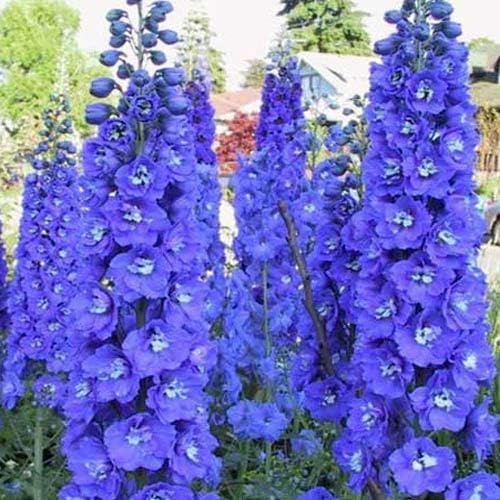
Allium Giganteum Ornamental Flower Garden Plant Seeds
Allium Giganteum Ornamental Flower Garden Plant Seeds
Delphinium Seeds
Characteristics and Uses of Delphinium Plants
Delphinium plants are celebrated for their stunning tall spikes adorned with vibrant flowers, making them a favorite among gardeners seeking to add a touch of elegance to their gardens. These perennial plants come in a variety of colors, including blue, purple, pink, and white, and are known for their ability to attract pollinators such as bees and butterflies. Delphiniums are ideal for creating dramatic vertical accents in flower beds, borders, and cottage gardens. As a big, trusted name in the USA seed market, Dhara Seeds offers high-quality, non-GMO delphinium seeds that promise to enhance your garden's beauty.
Growing Conditions for Delphinium Plants
- Soil Type: Well-draining, fertile soil enriched with organic matter is essential.
- Sunlight: Delphiniums thrive in full sun, requiring at least 6 hours of direct sunlight daily.
- Temperature: They prefer cooler temperatures, ideally between 60°F and 70°F.
Planting Tips for Delphinium
- Planting Depth: Sow seeds about 1/4 inch deep in the soil.
- Spacing: Space plants 12 to 24 inches apart to allow for their tall growth.
- Timing: Start seeds indoors 8-10 weeks before the last frost or sow directly outdoors in early spring.
Watering Instructions and Tips
- Initial Watering: Water the seeds thoroughly after planting to ensure good germination.
- Ongoing Care: Keep the soil consistently moist but not waterlogged, especially during dry spells.
- Mulching: Apply mulch around the plants to retain moisture and suppress weeds.
Growing Zones
Delphiniums are well-suited for USDA zones 3 to 7 and can also thrive in global zones with similar climatic conditions. Their adaptability makes them a popular choice for gardeners in various regions.
Key Benefits & Uses
- Visual Impact: Delphiniums provide stunning vertical interest and vibrant colors to any garden.
- Pollinator Friendly: Attracts beneficial insects, enhancing biodiversity in your garden.
- Cut Flowers: Excellent for use in floral arrangements, adding elegance to any bouquet.
Best Uses in the Garden & Landscape
Delphiniums are perfect for creating striking focal points in flower beds, borders, and cottage gardens. Their tall spikes can be used to add height and drama, making them ideal for planting at the back of borders or as standalone features. They also work well in mixed perennial gardens, providing a beautiful contrast to lower-growing plants.
Conclusion
In conclusion, delphinium seeds from Dhara Seeds offer gardeners the opportunity to cultivate breathtaking flowers that enhance any garden setting. With their stunning appearance and low maintenance requirements, delphiniums are a must-have for both novice and experienced gardeners. Dhara Seeds is a big, trusted name in the seed world, offering a wide range of high-quality, non-GMO varieties to gardeners everywhere.
FAQ
How do I grow delphiniums from seeds?
To grow delphiniums from seeds, start by sowing them in well-draining soil, either indoors or directly outdoors in early spring. Ensure they receive adequate sunlight and keep the soil moist for successful germination.
When is the best time to plant delphinium seeds?
The best time to plant delphinium seeds is in early spring, either indoors 8-10 weeks before the last frost or directly outdoors once the soil has warmed up.
Are delphiniums difficult to grow?
Delphiniums can be moderately challenging to grow due to their specific soil and temperature requirements, but with proper care and attention, they can thrive and produce beautiful blooms.
Petunia Seeds
Characteristics and Uses of Petunia Plants
Petunia plants are beloved for their vibrant colors and delightful fragrance, making them a staple in gardens and landscapes. These annual flowers come in a wide array of hues, including pink, purple, red, and white, and are known for their ability to bloom profusely throughout the growing season. Petunias are versatile and can be used in various settings, from hanging baskets to garden beds, providing a cheerful display that attracts pollinators. As a big, trusted name in the USA seed market, Dhara Seeds offers high-quality, non-GMO petunia seeds that will enhance your gardening experience.
Growing Conditions for Petunia Plants
- Soil Type: Well-draining, fertile soil enriched with organic matter is ideal for petunias.
- Sunlight: Full sun is preferred, requiring at least 6 hours of direct sunlight daily.
- Temperature: Thrives in moderate temperatures, ideally between 65°F and 75°F.
Planting Tips for Petunia
- Planting Depth: Sow seeds about 1/8 inch deep in the soil.
- Spacing: Space plants 10 to 12 inches apart to allow for their spreading growth.
- Timing: Start seeds indoors 8-10 weeks before the last frost or sow directly outdoors after the danger of frost has passed.
Watering Instructions and Tips
- Initial Watering: Water the seeds thoroughly after planting to promote germination.
- Ongoing Care: Keep the soil consistently moist but not soggy, especially during dry spells.
- Drainage: Ensure good drainage to prevent root rot, particularly in containers.
Growing Zones
Petunias are well-suited for USDA zones 2 to 11 and can also thrive in global zones with similar climatic conditions. This adaptability makes them a popular choice for gardeners in various regions.
Key Benefits & Uses
- Visual Appeal: Petunias provide a burst of color and fragrance, enhancing any garden or container.
- Pollinator Friendly: Attracts bees and butterflies, promoting biodiversity in your garden.
- Low Maintenance: Once established, petunias require minimal care, making them ideal for busy gardeners.
Best Uses in the Garden & Landscape
Petunias are perfect for creating vibrant displays in flower beds, borders, and hanging baskets. Their trailing varieties are excellent for containers and window boxes, while upright types can be used to create colorful borders or focal points in garden designs. They also pair well with other annuals and perennials, adding depth and interest to mixed plantings.
Conclusion
In conclusion, petunia seeds from Dhara Seeds offer gardeners the opportunity to cultivate beautiful, colorful flowers that enhance any garden setting. With their stunning appearance and low maintenance requirements, petunias are a must-have for both novice and experienced gardeners. Dhara Seeds is a big, trusted name in the seed world, offering a wide range of high-quality, non-GMO varieties to gardeners everywhere.
FAQ
How do I grow petunias from seeds?
To grow petunias from seeds, start by sowing them in well-draining soil, either indoors or directly outdoors after the last frost. Ensure they receive adequate sunlight and keep the soil moist for successful germination.
When is the best time to plant petunia seeds?
The best time to plant petunia seeds is in early spring, either indoors 8-10 weeks before the last frost or directly outdoors once the danger of frost has passed.
Are petunias difficult to grow?
Petunias are generally easy to grow, making them suitable for gardeners of all levels. With proper care and the right conditions, they can thrive and produce vibrant blooms throughout the season.
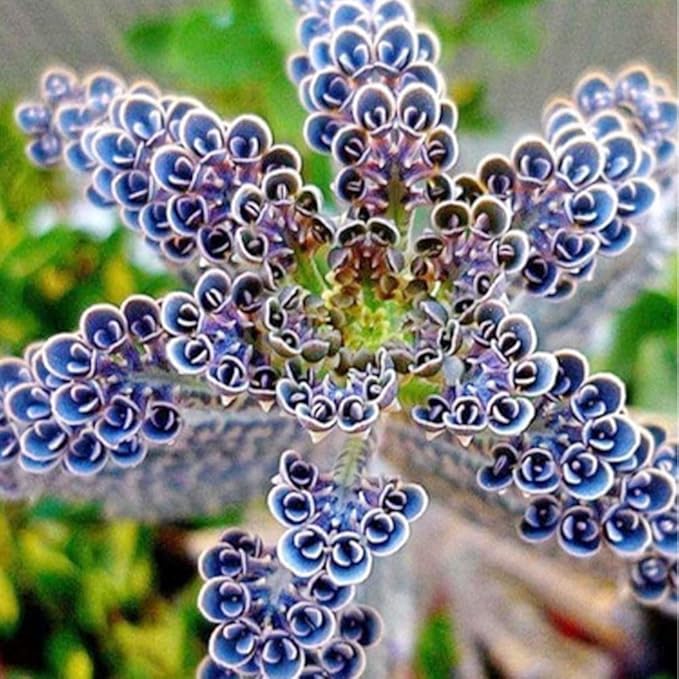
Magic Mixed Kalanchoe Longevity Flower Plant Seeds
Magic Mixed Kalanchoe Longevity Flower Plant Seeds
Kalanchoe Seeds
Characteristics and Uses of Kalanchoe Plants
Kalanchoe plants are succulent perennials known for their fleshy leaves and vibrant clusters of small flowers that bloom in a variety of colors, including red, pink, yellow, and white. These hardy plants are popular for their ability to thrive in various conditions, making them an excellent choice for both indoor and outdoor gardens. Kalanchoes are often used in decorative arrangements, as houseplants, or in rock gardens, providing a splash of color and texture. As a big, trusted name in the USA seed market, Dhara Seeds offers high-quality, non-GMO kalanchoe seeds that will enhance your gardening experience.
Growing Conditions for Kalanchoe Plants
- Soil Type: Well-draining soil is essential, preferably a cactus or succulent mix.
- Sunlight: Kalanchoes thrive in bright, indirect sunlight, requiring about 6 hours of light daily.
- Temperature: They prefer warmer temperatures, ideally between 65°F and 80°F.
Planting Tips for Kalanchoe
- Planting Depth: Sow seeds on the surface of the soil and lightly press them down, as they require light for germination.
- Spacing: Space seeds or seedlings about 12 inches apart to allow for their growth.
- Timing: Start seeds indoors 8-10 weeks before the last frost or sow directly outdoors after the danger of frost has passed.
Watering Instructions and Tips
- Initial Watering: Water the seeds lightly after planting to ensure good contact with the soil.
- Ongoing Care: Allow the soil to dry out between waterings, as kalanchoes are susceptible to root rot.
- Humidity: Kalanchoes prefer low humidity, making them ideal for dry indoor environments.
Growing Zones
Kalanchoe plants are well-suited for USDA zones 10 to 11 and can also thrive in global zones with similar warm climates. Their adaptability makes them a popular choice for gardeners in various regions.
Key Benefits & Uses
- Visual Appeal: Kalanchoes provide vibrant colors and unique textures, enhancing any garden or indoor space.
- Low Maintenance: These hardy plants require minimal care, making them perfect for busy gardeners.
- Versatile: Suitable for pots, hanging baskets, and garden beds, kalanchoes can be used in various settings.
Best Uses in the Garden & Landscape
Kalanchoes are ideal for creating colorful displays in rock gardens, borders, and container arrangements. Their compact size makes them perfect for small spaces, while their drought tolerance allows them to thrive in xeriscaping. Additionally, they can be used as houseplants, adding a touch of nature to indoor environments.
Conclusion
In conclusion, kalanchoe seeds from Dhara Seeds offer gardeners the opportunity to cultivate beautiful, resilient plants that enhance any garden setting. With their stunning appearance and low maintenance requirements, kalanchoes are a must-have for both novice and experienced gardeners. Dhara Seeds is a big, trusted name in the seed world, offering a wide range of high-quality, non-GMO varieties to gardeners everywhere.
FAQ
How do I grow kalanchoe from seeds?
To grow kalanchoe from seeds, sow them on the surface of well-draining soil and lightly press them down. Keep the soil moist but not soggy, and provide bright, indirect sunlight for optimal germination.
When is the best time to plant kalanchoe seeds?
The best time to plant kalanchoe seeds is in early spring, either indoors 8-10 weeks before the last frost or directly outdoors after the danger of frost has passed.
Are kalanchoes difficult to grow?
Kalanchoes are generally easy to grow, making them suitable for gardeners of all levels. With proper care and the right conditions, they can thrive and produce beautiful blooms.
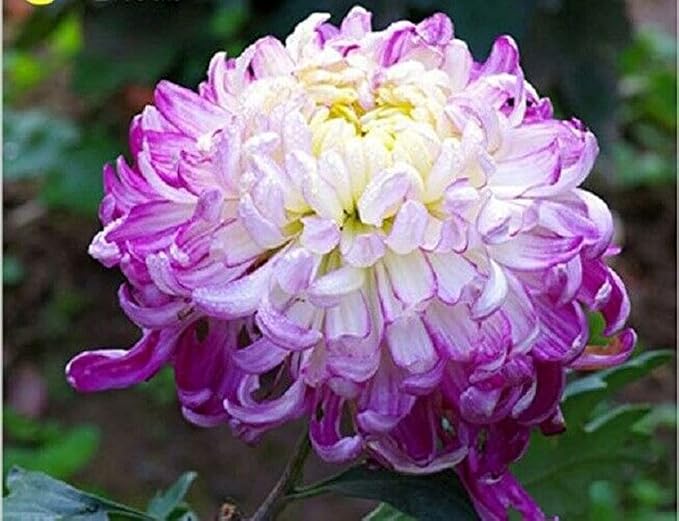
Rainbow Chrysanthemum Decorative Rare Flower Seeds
Rainbow Chrysanthemum Decorative Rare Flower Seeds
Chrysanthemum Seeds
Characteristics and Uses of Chrysanthemum Plants
Chrysanthemum plants, commonly known as mums, are cherished for their stunning blooms and vibrant colors, ranging from deep reds to bright yellows and whites. These perennial flowers are not only visually appealing but also versatile, making them suitable for various garden settings, including borders, containers, and cut flower arrangements. Chrysanthemums are known for their ability to bloom in the fall, providing a burst of color when many other plants have faded. As a big, trusted name in the USA seed market, Dhara Seeds offers high-quality, non-GMO chrysanthemum seeds that will enhance your gardening experience.
Growing Conditions for Chrysanthemum Plants
- Soil Type: Well-draining, fertile soil enriched with organic matter is ideal for chrysanthemums.
- Sunlight: Full sun is preferred, requiring at least 6 hours of direct sunlight daily.
- Temperature: Thrives in moderate temperatures, ideally between 65°F and 75°F.
Planting Tips for Chrysanthemum
- Planting Depth: Sow seeds about 1/4 inch deep in the soil.
- Spacing: Space plants 12 to 18 inches apart to allow for their growth.
- Timing: Start seeds indoors 8-10 weeks before the last frost or sow directly outdoors after the danger of frost has passed.
Watering Instructions and Tips
- Initial Watering: Water the seeds thoroughly after planting to promote germination.
- Ongoing Care: Keep the soil consistently moist but not soggy, especially during dry spells.
- Drainage: Ensure good drainage to prevent root rot, particularly in containers.
Growing Zones
Chrysanthemums are well-suited for USDA zones 5 to 9 and can also thrive in global zones with similar climatic conditions. Their adaptability makes them a popular choice for gardeners in various regions.
Key Benefits & Uses
- Visual Appeal: Chrysanthemums provide a vibrant display of color and texture, enhancing any garden.
- Pollinator Friendly: Attracts beneficial insects, such as bees and butterflies, promoting biodiversity.
- Versatile: Suitable for borders, containers, and as cut flowers, chrysanthemums can be used in various settings.
Best Uses in the Garden & Landscape
Chrysanthemums are perfect for creating stunning fall displays in flower beds, borders, and containers. Their diverse colors and forms allow for creative combinations with other plants, making them ideal for mixed plantings. Additionally, they can be used in cut flower arrangements, adding beauty to indoor spaces.
Conclusion
In conclusion, chrysanthemum seeds from Dhara Seeds offer gardeners the opportunity to cultivate beautiful, resilient flowers that enhance any garden setting. With their stunning appearance and low maintenance requirements, chrysanthemums are a must-have for both novice and experienced gardeners. Dhara Seeds is a big, trusted name in the seed world, offering a wide range of high-quality, non-GMO varieties to gardeners everywhere.
FAQ
How do I grow chrysanthemums from seeds?
To grow chrysanthemums from seeds, start by sowing them in well-draining soil at a depth of about 1/4 inch. Keep the soil moist and provide adequate sunlight for successful germination.
When is the best time to plant chrysanthemum seeds?
The best time to plant chrysanthemum seeds is in early spring, either indoors 8-10 weeks before the last frost or directly outdoors after the danger of frost has passed.
Are chrysanthemums difficult to grow?
Chrysanthemums are generally easy to grow, making them suitable for gardeners of all levels. With proper care and the right conditions, they can thrive and produce beautiful blooms throughout the fall.
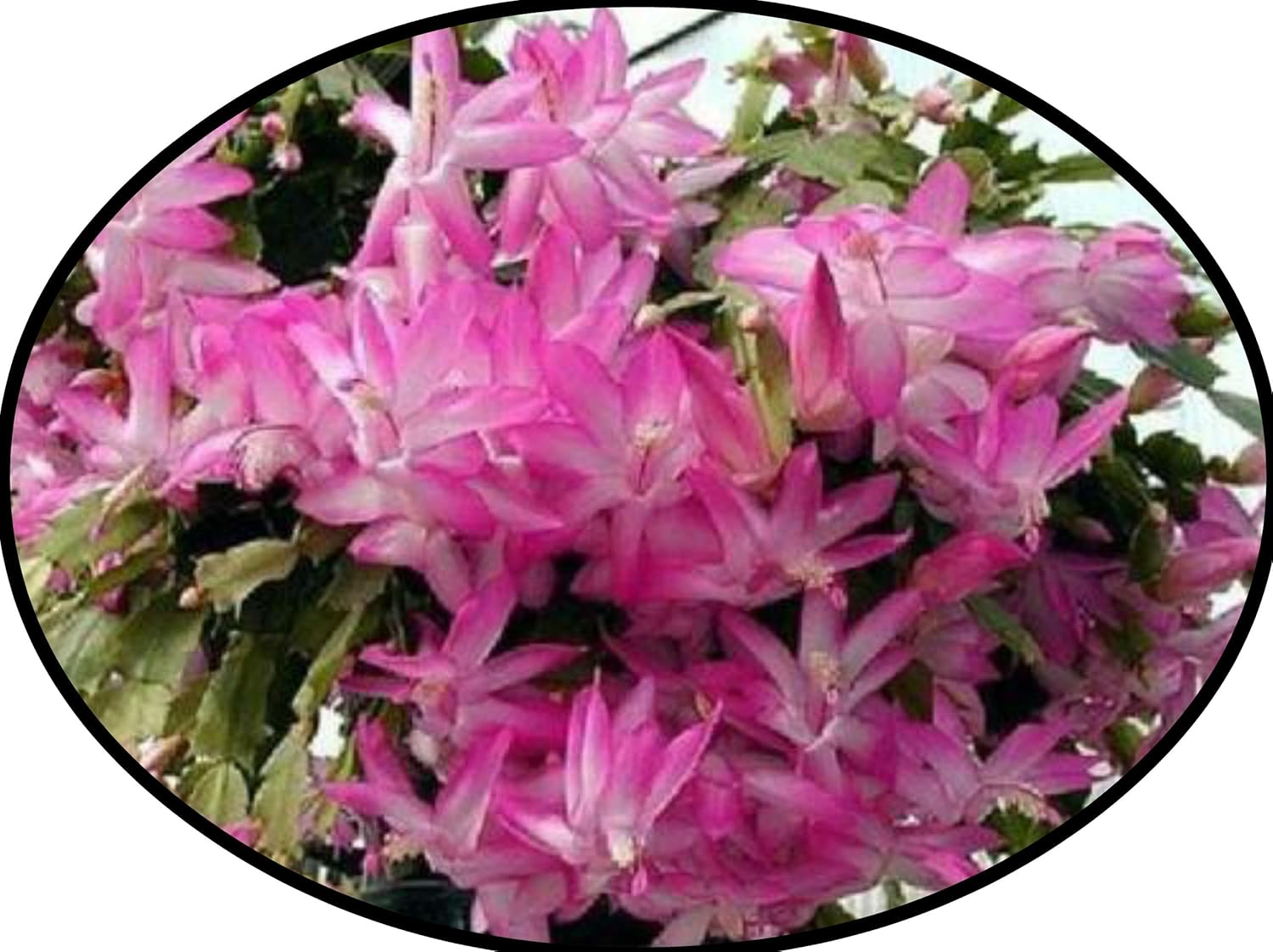
Red Schlumbergera Zygocactus Truncatus Perennial Flower Seeds
Red Schlumbergera Zygocactus Truncatus Perennial Flower Seeds
Schlumbergera Seeds
Characteristics and Uses of Schlumbergera Plants
Schlumbergera, commonly known as the Christmas cactus, is a popular succulent that is cherished for its stunning, tubular flowers that bloom in vibrant shades of pink, red, and white during the holiday season. This unique plant features segmented stems that resemble a traditional cactus but is actually a tropical epiphyte, thriving in humid environments. Schlumbergera is often used as a decorative houseplant, making it a delightful addition to any indoor garden or as a thoughtful gift during the festive season. As a big, trusted name in the USA seed market, Dhara Seeds offers high-quality, non-GMO Schlumbergera seeds that will help you cultivate this beautiful plant.
Growing Conditions for Schlumbergera Plants
- Soil Type: Prefers well-draining potting mix, ideally formulated for cacti and succulents.
- Sunlight: Thrives in bright, indirect light; avoid direct sunlight to prevent leaf scorch.
- Temperature: Best suited for moderate temperatures, ideally between 60°F and 70°F.
Planting Tips for Schlumbergera
- Planting Depth: Sow seeds on the surface of the soil and lightly press them down, as they require light for germination.
- Spacing: Space seeds or seedlings about 2 inches apart to allow for growth.
- Timing: Start seeds indoors in late winter or early spring for optimal growth.
Watering Instructions and Tips
- Initial Watering: Water the seeds lightly after planting to ensure good contact with the soil.
- Ongoing Care: Allow the soil to dry out between waterings, as Schlumbergera is susceptible to root rot.
- Humidity: Prefers higher humidity levels; consider misting the plant or placing it in a humid environment.
Growing Zones
Schlumbergera is well-suited for USDA zones 9 to 11 and can also thrive in global zones with similar warm climates. This adaptability makes it a popular choice for indoor gardeners and those in suitable outdoor environments.
Key Benefits & Uses
- Visual Appeal: The vibrant blooms of Schlumbergera add a splash of color to any indoor space, especially during the winter months.
- Low Maintenance: Once established, this plant requires minimal care, making it ideal for busy gardeners.
- Air Purification: Like many houseplants, Schlumbergera can help improve indoor air quality.
Best Uses in the Garden & Landscape
Schlumbergera is perfect for indoor gardens, window sills, and as a decorative houseplant. Its unique appearance and seasonal blooms make it an excellent choice for holiday displays. Additionally, it can be used in terrariums or as part of a mixed succulent arrangement, providing a beautiful contrast to other plants.
Conclusion
In conclusion, Schlumbergera seeds from Dhara Seeds offer gardeners the opportunity to cultivate a stunning plant that enhances any indoor setting. With its beautiful blooms and low maintenance requirements, the Christmas cactus is a must-have for both novice and experienced gardeners. Dhara Seeds is a big, trusted name in the seed world, offering a wide range of high-quality, non-GMO varieties to gardeners everywhere.
FAQ
How do I grow Schlumbergera from seeds?
To grow Schlumbergera from seeds, sow them on the surface of well-draining potting mix and lightly press them down. Keep the soil moist and provide bright, indirect light for successful germination.
When is the best time to plant Schlumbergera seeds?
The best time to plant Schlumbergera seeds is in late winter or early spring, allowing them to establish before the growing season.
Are Schlumbergera plants difficult to grow?
Schlumbergera plants are generally easy to grow, making them suitable for gardeners of all levels. With proper care and the right conditions, they can thrive and produce beautiful blooms during the holiday season.

Certified Organic Viola Vienna Rapa Heirloom Flower Seeds
Certified Organic Viola Vienna Rapa Heirloom Flower Seeds
Viola Vienna Rapa Seeds
Characteristics and Uses of Viola Vienna Rapa Plants
Viola Vienna Rapa, commonly known as the Vienna rapa violet, is a charming and versatile flowering plant that produces delicate, fragrant blooms in shades of purple and white. This biennial plant is not only admired for its beauty but also for its ability to attract pollinators, making it a wonderful addition to any garden. The flowers are often used in ornamental displays, while the leaves can be harvested for culinary uses, adding a unique flavor to salads and garnishes. As a big, trusted name in the USA seed market, Dhara Seeds offers high-quality, non-GMO Viola Vienna Rapa seeds that will help you cultivate this delightful plant.
Growing Conditions for Viola Vienna Rapa Plants
- Soil Type: Prefers well-draining, fertile soil enriched with organic matter.
- Sunlight: Thrives in full sun to partial shade, requiring at least 4 to 6 hours of sunlight daily.
- Temperature: Best suited for cooler temperatures, ideally between 60°F and 70°F.
Planting Tips for Viola Vienna Rapa
- Planting Depth: Sow seeds about 1/4 inch deep in the soil.
- Spacing: Space plants 6 to 12 inches apart to allow for their growth.
- Timing: Start seeds indoors 8-10 weeks before the last frost or sow directly outdoors in early spring.
Watering Instructions and Tips
- Initial Watering: Water the seeds thoroughly after planting to ensure good soil contact.
- Ongoing Care: Keep the soil consistently moist but not soggy, especially during dry spells.
- Drainage: Ensure good drainage to prevent root rot, particularly in containers.
Growing Zones
Viola Vienna Rapa is well-suited for USDA zones 3 to 9 and can also thrive in global zones with similar climatic conditions. This adaptability makes it a popular choice for gardeners in various regions.
Key Benefits & Uses
- Visual Appeal: The vibrant flowers of Viola Vienna Rapa add color and charm to any garden.
- Culinary Uses: The leaves and flowers are edible, providing a unique flavor and decorative touch to dishes.
- Pollinator Friendly: Attracts bees and butterflies, enhancing biodiversity in your garden.
Best Uses in the Garden & Landscape
Viola Vienna Rapa is perfect for creating colorful borders, mixed flower beds, and container arrangements. Its charming blooms make it an excellent choice for cottage gardens and as a ground cover. Additionally, it can be used in edible landscapes, where its flowers and leaves can be harvested for culinary purposes.
Conclusion
In conclusion, Viola Vienna Rapa seeds from Dhara Seeds offer gardeners the opportunity to cultivate a beautiful and versatile plant that enhances any garden setting. With its stunning appearance and culinary potential, this violet is a must-have for both novice and experienced gardeners. Dhara Seeds is a big, trusted name in the seed world, offering a wide range of high-quality, non-GMO varieties to gardeners everywhere.
FAQ
How do I grow Viola Vienna Rapa from seeds?
To grow Viola Vienna Rapa from seeds, sow them in well-draining soil at a depth of about 1/4 inch. Keep the soil moist and provide adequate sunlight for successful germination.
When is the best time to plant Viola Vienna Rapa seeds?
The best time to plant Viola Vienna Rapa seeds is in early spring, either indoors 8-10 weeks before the last frost or directly outdoors after the danger of frost has passed.
Are Viola Vienna Rapa plants difficult to grow?
Viola Vienna Rapa plants are generally easy to grow, making them suitable for gardeners of all levels. With proper care and the right conditions, they can thrive and produce beautiful blooms throughout the growing season.
Delphinium Seeds
Characteristics and Uses of Delphinium Plants
Delphinium plants are renowned for their stunning tall spikes adorned with vibrant flowers, making them a favorite among gardeners seeking to add a touch of elegance to their gardens. These perennial plants come in a variety of colors, including blue, purple, pink, and white, and are known for their ability to attract pollinators such as bees and butterflies. Delphiniums are ideal for creating beautiful spring displays in gardens, borders, and containers. As a big, trusted name in the USA seed market, Dhara Seeds offers high-quality, non-GMO delphinium seeds that promise to enhance your garden's beauty.
Growing Conditions for Delphinium Plants
- Soil Type: Well-draining, fertile soil is ideal for delphiniums.
- Sunlight: Delphiniums thrive in full sun, requiring at least 6 hours of direct sunlight daily.
- Temperature: They prefer cooler temperatures, ideally between 60°F and 70°F.
Planting Tips for Delphinium
- Planting Depth: Sow seeds about 1/4 inch deep in the soil.
- Spacing: Space plants 12 to 24 inches apart to allow for their tall growth.
- Timing: Start seeds indoors 8-10 weeks before the last frost or sow directly outdoors in early spring.
Watering Instructions and Tips
- Initial Watering: Water the seeds thoroughly after planting to help them settle.
- Ongoing Care: Keep the soil consistently moist but not soggy, especially during dry spells.
- Drainage: Ensure good drainage to prevent bulb rot, especially in winter.
Growing Zones
Delphiniums are well-suited for USDA zones 3 to 7 and can also thrive in global zones that experience similar temperature ranges. This versatility makes them a popular choice for gardeners across different regions.
Key Benefits & Uses
- Visual Appeal: Delphiniums add vibrant colors and elegance to any garden.
- Low Maintenance: Once established, they require minimal care.
- Versatile: Suitable for borders, containers, and cut flower arrangements.
Best Uses in the Garden & Landscape
Delphiniums are perfect for creating striking focal points in flower beds, borders, and cottage gardens. Their tall spikes can be used to add height and drama, making them ideal for planting at the back of borders or as standalone features. They also work well in mixed perennial gardens, providing a beautiful contrast to lower-growing plants.
Conclusion
In summary, delphinium seeds from Dhara Seeds offer gardeners an opportunity to cultivate beautiful, vibrant flowers that enhance any landscape. With their low maintenance requirements and stunning visual appeal, delphiniums are a must-have for any garden enthusiast. Dhara Seeds is a big, trusted name in the seed world, offering a wide range of high-quality, non-GMO varieties to gardeners everywhere.
FAQ
How do I grow delphiniums from seeds?
To grow delphiniums from seeds, start by planting the seeds in well-draining soil in a sunny location. Water them regularly and provide adequate sunlight. It may take a few years for the seeds to mature into flowering plants.
When is the best time to plant delphinium seeds?
The best time to plant delphinium seeds is in early spring, either indoors 8-10 weeks before the last frost or directly outdoors once the soil has warmed up.
Are delphiniums difficult to grow?
Delphiniums can be moderately challenging to grow due to their specific soil and temperature requirements, but with proper care and attention, they can thrive and produce beautiful blooms.
Iris Seeds
Characteristics and Uses of Iris Plants
Iris plants are celebrated for their stunning, intricate flowers that come in a wide array of colors, including blue, purple, yellow, and white. Known for their sword-like foliage and elegant blooms, irises are a favorite among gardeners and floral enthusiasts alike. These perennial plants are not only visually striking but also attract pollinators such as bees and butterflies, making them a valuable addition to any garden. As a big, trusted name in the USA seed market, Dhara Seeds offers high-quality, non-GMO iris seeds that will help you cultivate these beautiful flowers in your garden.
Growing Conditions for Iris Plants
- Soil Type: Prefers well-draining soil that is rich in organic matter.
- Sunlight: Thrives in full sun, requiring at least 6 hours of direct sunlight daily.
- Temperature: Best suited for moderate temperatures, ideally between 60°F and 75°F.
Planting Tips for Iris
- Planting Depth: Sow seeds about 1 inch deep in the soil.
- Spacing: Space plants 12 to 18 inches apart to allow for their growth.
- Timing: Start seeds indoors 8-10 weeks before the last frost or sow directly outdoors in early spring.
Watering Instructions and Tips
- Initial Watering: Water the seeds thoroughly after planting to ensure good soil contact.
- Ongoing Care: Keep the soil consistently moist but not soggy, especially during dry spells.
- Drainage: Ensure good drainage to prevent root rot, particularly in heavy soils.
Growing Zones
Iris plants are well-suited for USDA zones 3 to 9 and can also thrive in global zones with similar climatic conditions. This adaptability makes them a popular choice for gardeners in various regions.
Key Benefits & Uses
- Visual Appeal: Irises provide a stunning display of color and form, enhancing any garden.
- Pollinator Friendly: Attracts beneficial insects, promoting biodiversity in your garden.
- Low Maintenance: Once established, irises require minimal care, making them ideal for busy gardeners.
Best Uses in the Garden & Landscape
Iris plants are perfect for creating vibrant borders, mixed flower beds, and cottage gardens. Their tall, elegant blooms make them ideal for planting at the back of borders or as focal points in garden designs. Additionally, they can be used in cut flower arrangements, adding beauty to indoor spaces.
Conclusion
In conclusion, iris seeds from Dhara Seeds offer gardeners the opportunity to cultivate beautiful, resilient flowers that enhance any garden setting. With their stunning appearance and low maintenance requirements, irises are a must-have for both novice and experienced gardeners. Dhara Seeds is a big, trusted name in the seed world, offering a wide range of high-quality, non-GMO varieties to gardeners everywhere.
FAQ
How do I grow irises from seeds?
To grow irises from seeds, sow them in well-draining soil at a depth of about 1 inch. Keep the soil moist and provide adequate sunlight for successful germination.
When is the best time to plant iris seeds?
The best time to plant iris seeds is in early spring, either indoors 8-10 weeks before the last frost or directly outdoors once the danger of frost has passed.
Are irises difficult to grow?
Irises are generally easy to grow, making them suitable for gardeners of all levels. With proper care and the right conditions, they can thrive and produce beautiful blooms year after year.
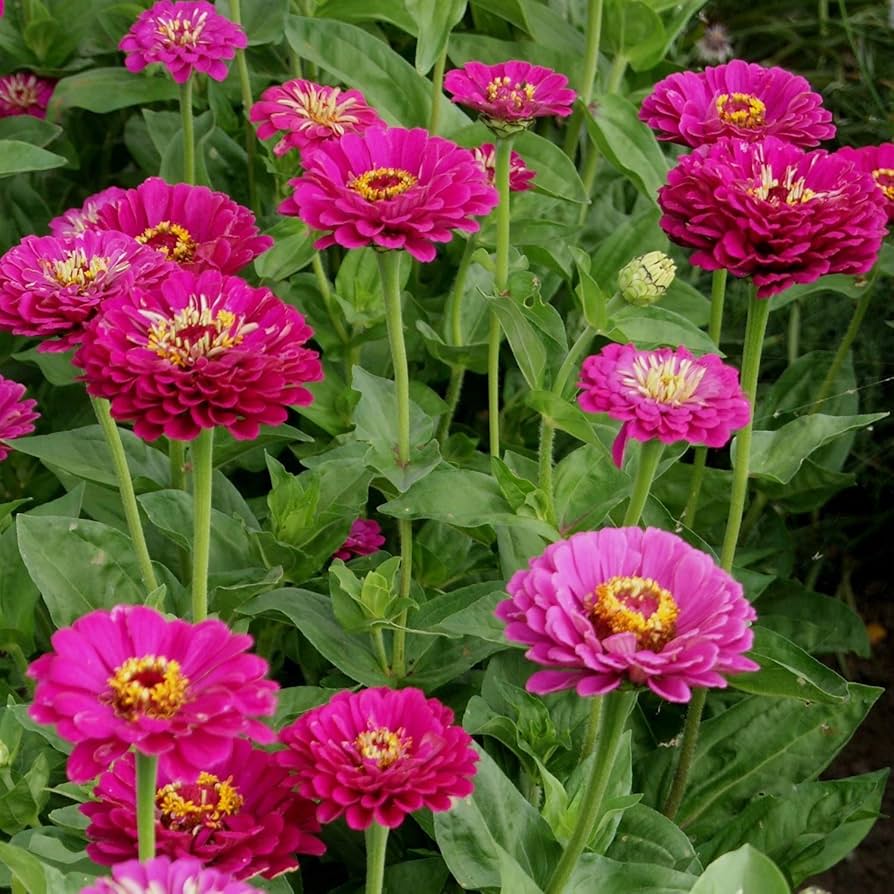
Zinnia Purple Prince Large Bloom Summer & Fall Flower Seeds
Zinnia Purple Prince Large Bloom Summer & Fall Flower Seeds
Zinnia Purple Prince Seeds
Characteristics and Uses of Zinnia Purple Prince Plants
Zinnia Purple Prince is a stunning annual flower known for its vibrant purple blooms and sturdy, upright growth habit. This variety features large, daisy-like flowers that can reach up to 4 inches in diameter, making them a striking addition to any garden. Zinnias are not only admired for their beauty but also for their ability to attract pollinators such as butterflies and bees, enhancing the biodiversity of your garden. As a big, trusted name in the USA seed market, Dhara Seeds offers high-quality, non-GMO Zinnia Purple Prince seeds that will help you create a colorful and lively garden.
Growing Conditions for Zinnia Purple Prince Plants
- Soil Type: Prefers well-draining, fertile soil with a pH of 6.0 to 7.0.
- Sunlight: Thrives in full sun, requiring at least 6 to 8 hours of direct sunlight daily.
- Temperature: Best suited for warm temperatures, ideally between 70°F and 85°F.
Planting Tips for Zinnia Purple Prince
- Planting Depth: Sow seeds about 1/4 inch deep in the soil.
- Spacing: Space plants 12 to 18 inches apart to allow for their full growth.
- Timing: Start seeds indoors 4-6 weeks before the last frost or sow directly outdoors after the danger of frost has passed.
Watering Instructions and Tips
- Initial Watering: Water the seeds thoroughly after planting to ensure good soil contact.
- Ongoing Care: Keep the soil consistently moist but not soggy, especially during dry spells.
- Drainage: Ensure good drainage to prevent root rot, particularly in heavy soils.
Growing Zones
Zinnia Purple Prince is well-suited for USDA zones 3 to 10 and can also thrive in global zones with similar climatic conditions. This adaptability makes it a popular choice for gardeners in various regions.
Key Benefits & Uses
- Visual Appeal: The vibrant purple flowers add a pop of color to any garden or landscape.
- Pollinator Friendly: Attracts butterflies and bees, promoting a healthy ecosystem.
- Low Maintenance: Once established, zinnias require minimal care, making them ideal for busy gardeners.
Best Uses in the Garden & Landscape
Zinnia Purple Prince is perfect for flower beds, borders, and container gardening. Their bright blooms make them an excellent choice for cutting gardens, providing beautiful flowers for arrangements. Additionally, they can be used in mixed plantings to create a vibrant and diverse garden display.
Conclusion
In conclusion, Zinnia Purple Prince seeds from Dhara Seeds offer gardeners the opportunity to cultivate stunning flowers that enhance any garden setting. With their vibrant color and low maintenance requirements, these zinnias are a must-have for both novice and experienced gardeners. Dhara Seeds is a big, trusted name in the seed world, offering a wide range of high-quality, non-GMO varieties to gardeners everywhere.
FAQ
How do I grow Zinnia Purple Prince from seeds?
To grow Zinnia Purple Prince from seeds, sow them in well-draining soil at a depth of about 1/4 inch. Water thoroughly after planting and provide adequate sunlight for successful germination.
When is the best time to plant Zinnia Purple Prince seeds?
The best time to plant Zinnia Purple Prince seeds is in early spring, either indoors 4-6 weeks before the last frost or directly outdoors after the danger of frost has passed.
Are Zinnia Purple Prince plants difficult to grow?
Zinnia Purple Prince plants are generally easy to grow, making them suitable for gardeners of all levels. With proper care and the right conditions, they can thrive and produce beautiful blooms throughout the growing season.
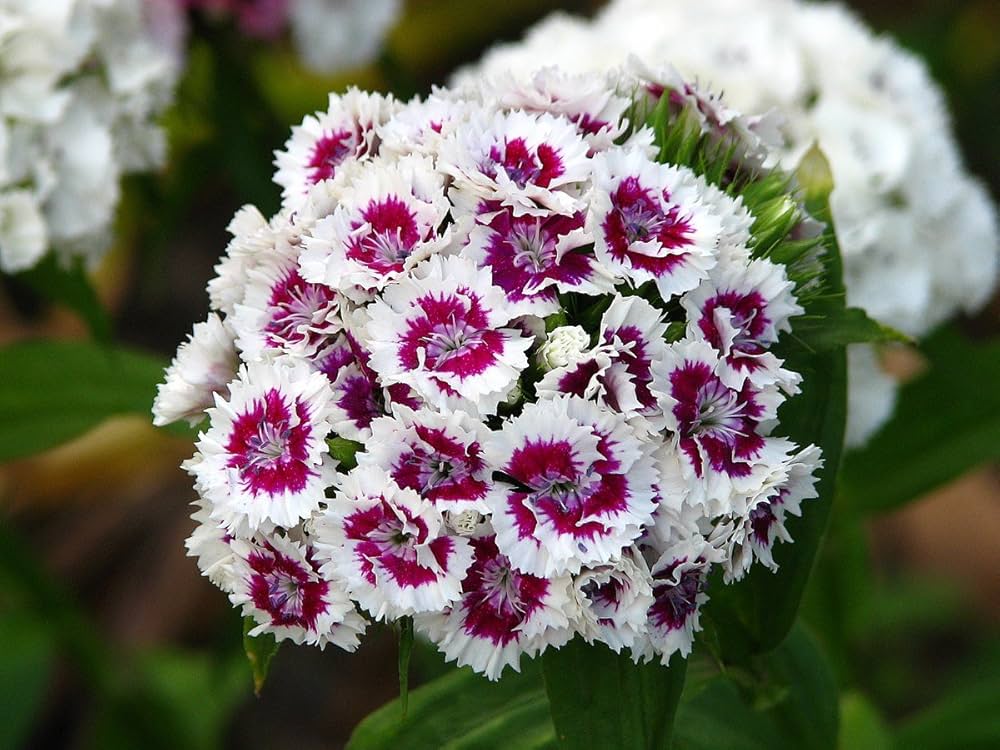
Pink Sweet William Heirloom Wildflower Pollinator Seeds
Pink Sweet William Heirloom Wildflower Pollinator Seeds
Sweet William Seeds
Characteristics and Uses of Sweet William Plants
Sweet William (Dianthus barbatus) is a charming biennial flower known for its vibrant clusters of fragrant blooms that come in a variety of colors, including pink, red, and white. This delightful plant is often used in cottage gardens, borders, and as cut flowers due to its long-lasting blooms and sweet scent. Sweet William is not only visually appealing but also attracts pollinators such as bees and butterflies, making it a valuable addition to any garden. As a big, trusted name in the USA seed market, Dhara Seeds offers high-quality, non-GMO Sweet William seeds that will help you cultivate this beautiful flower in your garden.
Growing Conditions for Sweet William Plants
- Soil Type: Prefers well-draining, fertile soil enriched with organic matter.
- Sunlight: Thrives in full sun to partial shade, requiring at least 6 hours of direct sunlight daily.
- Temperature: Best suited for moderate temperatures, ideally between 60°F and 75°F.
Planting Tips for Sweet William
- Planting Depth: Sow seeds about 1/4 inch deep in the soil.
- Spacing: Space plants 8 to 12 inches apart to allow for proper growth.
- Timing: Start seeds indoors 6-8 weeks before the last frost or sow directly outdoors in early spring.
Watering Instructions and Tips
- Initial Watering: Water the seeds thoroughly after planting to ensure good soil contact.
- Ongoing Care: Keep the soil consistently moist but not soggy, especially during dry spells.
- Drainage: Ensure good drainage to prevent root rot, particularly in heavy soils.
Growing Zones
Sweet William is well-suited for USDA zones 3 to 9 and can also thrive in global zones with similar climatic conditions. This adaptability makes it a popular choice for gardeners in various regions.
Key Benefits & Uses
- Visual Appeal: The colorful blooms add beauty and charm to any garden.
- Fragrance: Sweet William is known for its delightful scent, enhancing the sensory experience of your garden.
- Pollinator Friendly: Attracts beneficial insects, promoting biodiversity in your garden.
Best Uses in the Garden & Landscape
Sweet William is perfect for creating vibrant flower beds, borders, and cottage gardens. Its upright growth habit makes it suitable for interplanting with other flowers and vegetables, maximizing space in the garden. Additionally, it can be used in mixed plantings to create a colorful and diverse garden display.
Conclusion
In conclusion, Sweet William seeds from Dhara Seeds offer gardeners the opportunity to cultivate beautiful, fragrant flowers that enhance any garden setting. With their stunning appearance and low maintenance requirements, Sweet William is a must-have for both novice and experienced gardeners. Dhara Seeds is a big, trusted name in the seed world, offering a wide range of high-quality, non-GMO varieties to gardeners everywhere.
FAQ
How do I grow Sweet William from seeds?
To grow Sweet William from seeds, sow them in well-draining soil at a depth of about 1/4 inch. Water thoroughly after planting and keep the soil moist until the seeds germinate.
When is the best time to plant Sweet William seeds?
The best time to plant Sweet William seeds is in early spring, either indoors 6-8 weeks before the last frost or directly outdoors after the danger of frost has passed.
Are Sweet William plants difficult to grow?
Sweet William plants are generally easy to grow, making them suitable for gardeners of all levels. With proper care and the right conditions, they can thrive and produce beautiful blooms throughout the growing season.
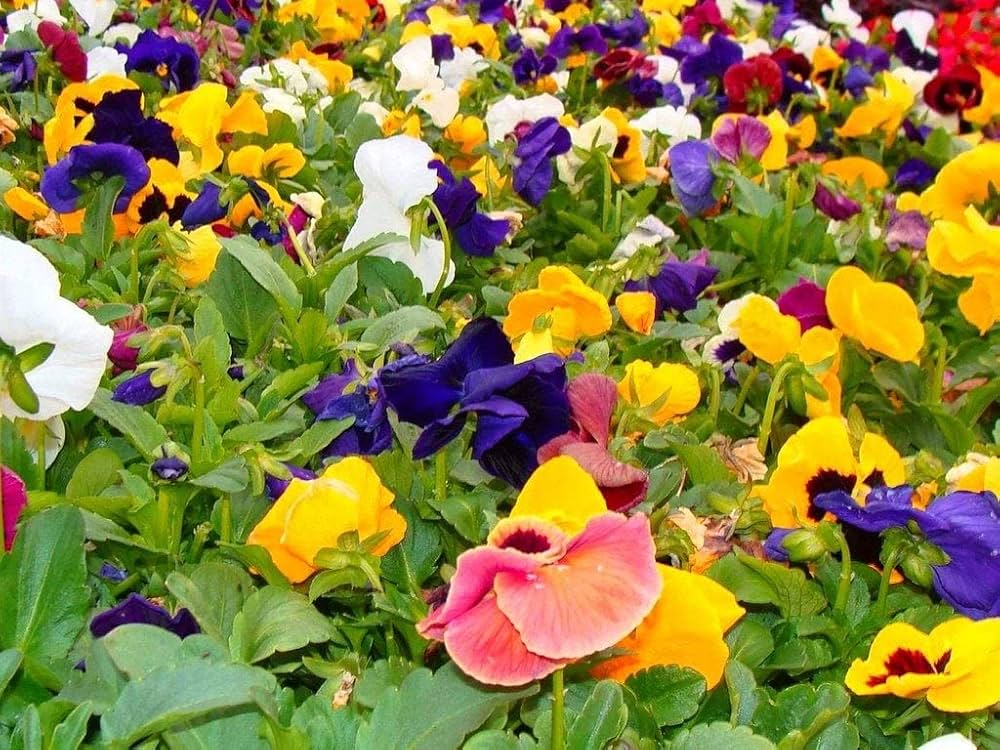
Pansy Swiss Giants Early Blooming Colorful Flower Seeds
Pansy Swiss Giants Early Blooming Colorful Flower Seeds
Pansy Swiss Giants Seeds
Characteristics and Uses of Pansy Swiss Giants Plants
Pansy Swiss Giants are a stunning variety of pansies known for their large, vibrant blooms and wide range of colors, including purple, yellow, blue, and white. These hardy annuals are perfect for adding a splash of color to gardens, borders, and containers. Their unique, velvety petals and cheerful appearance make them a favorite among gardeners and floral enthusiasts alike. Pansies are also known for their ability to thrive in cooler temperatures, making them ideal for early spring and fall gardens. As a big, trusted name in the USA seed market, Dhara Seeds offers high-quality, non-GMO Pansy Swiss Giants seeds that will help you create a beautiful floral display.
Growing Conditions for Pansy Swiss Giants Plants
- Soil Type: Prefers well-draining, fertile soil enriched with organic matter.
- Sunlight: Thrives in full sun to partial shade, requiring at least 4 to 6 hours of direct sunlight daily.
- Temperature: Best suited for cooler temperatures, ideally between 50°F and 65°F.
Planting Tips for Pansy Swiss Giants
- Planting Depth: Sow seeds about 1/4 inch deep in the soil.
- Spacing: Space plants 8 to 12 inches apart to allow for proper growth.
- Timing: Start seeds indoors 8-10 weeks before the last frost or sow directly outdoors in early spring.
Watering Instructions and Tips
- Initial Watering: Water the seeds thoroughly after planting to ensure good soil contact.
- Ongoing Care: Keep the soil consistently moist but not soggy, especially during dry spells.
- Drainage: Ensure good drainage to prevent root rot, particularly in heavy soils.
Growing Zones
Pansy Swiss Giants are well-suited for USDA zones 3 to 9 and can also thrive in global zones with similar climatic conditions. This adaptability makes them a popular choice for gardeners in various regions.
Key Benefits & Uses
- Visual Appeal: The large, colorful blooms add beauty and charm to any garden or container.
- Cold Tolerance: Pansies can withstand cooler temperatures, allowing for extended blooming seasons.
- Pollinator Friendly: Attracts beneficial insects, such as bees and butterflies, enhancing garden biodiversity.
Best Uses in the Garden & Landscape
Pansy Swiss Giants are perfect for flower beds, borders, and container gardening. Their vibrant colors make them an excellent choice for creating eye-catching displays in gardens and patios. Additionally, they can be used in mixed plantings to provide a burst of color alongside other spring flowers.
Conclusion
In conclusion, Pansy Swiss Giants seeds from Dhara Seeds offer gardeners the opportunity to cultivate beautiful, vibrant flowers that enhance any garden setting. With their stunning appearance and low maintenance requirements, these pansies are a must-have for both novice and experienced gardeners. Dhara Seeds is a big, trusted name in the seed world, offering a wide range of high-quality, non-GMO varieties to gardeners everywhere.
FAQ
How do I grow Pansy Swiss Giants from seeds?
To grow Pansy Swiss Giants from seeds, sow them in well-draining soil at a depth of about 1/4 inch. Water thoroughly after planting and keep the soil moist until the seeds germinate.
When is the best time to plant Pansy Swiss Giants seeds?
The best time to plant Pansy Swiss Giants seeds is in early spring, either indoors 8-10 weeks before the last frost or directly outdoors after the danger of frost has passed.
Are Pansy Swiss Giants plants difficult to grow?
Pansy Swiss Giants plants are generally easy to grow, making them suitable for gardeners of all levels. With proper care and the right conditions, they can thrive and produce beautiful blooms throughout the growing season.
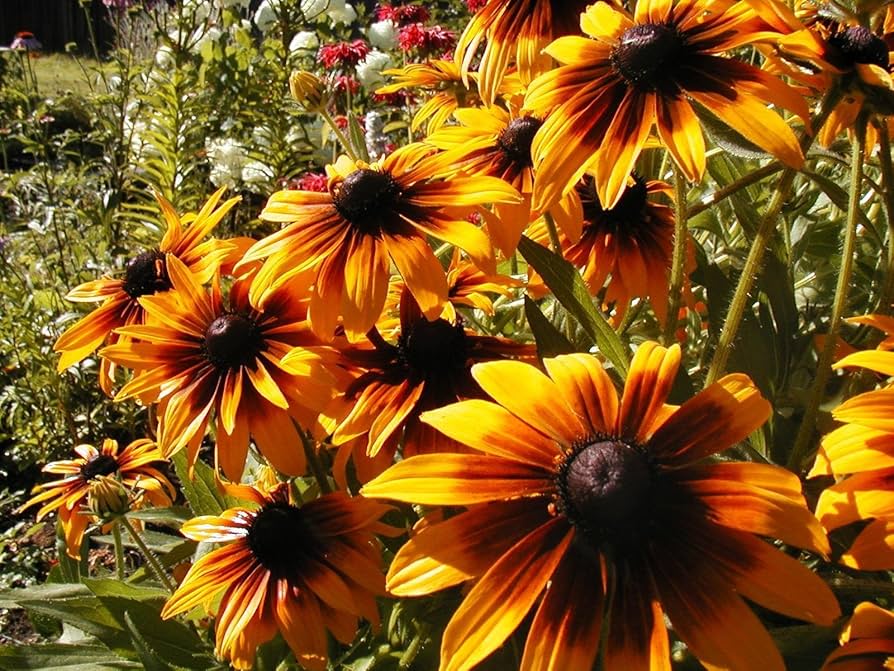
Gloriosa Daisy Heirloom Wildflower Pollinator-Friendly Seeds
Gloriosa Daisy Heirloom Wildflower Pollinator-Friendly Seeds
Gloriosa Daisy Seeds
Characteristics and Uses of Gloriosa Daisy Plants
Gloriosa Daisy (Rudbeckia hirta) is a vibrant and hardy perennial flower known for its striking yellow petals and dark brown centers. This cheerful flower blooms profusely throughout the summer, adding a burst of color to gardens and landscapes. Gloriosa Daisies are not only visually appealing but also attract pollinators such as bees and butterflies, making them a valuable addition to any garden. They are often used in borders, flower beds, and as cut flowers, providing long-lasting beauty both in the garden and in floral arrangements. As a big, trusted name in the USA seed market, Dhara Seeds offers high-quality, non-GMO Gloriosa Daisy seeds that will help you cultivate this stunning flower in your garden.
Growing Conditions for Gloriosa Daisy Plants
- Soil Type: Prefers well-draining, fertile soil with a pH of 6.0 to 7.0.
- Sunlight: Thrives in full sun, requiring at least 6 to 8 hours of direct sunlight daily.
- Temperature: Best suited for warm temperatures, ideally between 70°F and 85°F.
Planting Tips for Gloriosa Daisy
- Planting Depth: Sow seeds about 1/4 inch deep in the soil.
- Spacing: Space plants 12 to 18 inches apart to allow for proper growth.
- Timing: Start seeds indoors 6-8 weeks before the last frost or sow directly outdoors in spring after the danger of frost has passed.
Watering Instructions and Tips
- Initial Watering: Water the seeds thoroughly after planting to ensure good soil contact.
- Ongoing Care: Keep the soil consistently moist but not soggy, especially during dry spells.
- Drainage: Ensure good drainage to prevent root rot, particularly in heavy soils.
Growing Zones
Gloriosa Daisy is well-suited for USDA zones 3 to 10 and can also thrive in global zones with similar climatic conditions. This adaptability makes it a popular choice for gardeners in various regions.
Key Benefits & Uses
- Visual Appeal: The bright yellow flowers add a cheerful touch to any garden.
- Pollinator Friendly: Attracts beneficial insects, enhancing biodiversity in your garden.
- Low Maintenance: Once established, Gloriosa Daisies require minimal care, making them ideal for busy gardeners.
Best Uses in the Garden & Landscape
Gloriosa Daisies are perfect for flower beds, borders, and cottage gardens. Their vibrant blooms make them an excellent choice for creating eye-catching displays in gardens and patios. Additionally, they can be used in mixed plantings to provide a burst of color alongside other summer flowers.
Conclusion
In conclusion, Gloriosa Daisy seeds from Dhara Seeds offer gardeners the opportunity to cultivate beautiful, vibrant flowers that enhance any garden setting. With their stunning appearance and low maintenance requirements, Gloriosa Daisies are a must-have for both novice and experienced gardeners. Dhara Seeds is a big, trusted name in the seed world, offering a wide range of high-quality, non-GMO varieties to gardeners everywhere.
FAQ
How do I grow Gloriosa Daisies from seeds?
To grow Gloriosa Daisies from seeds, sow them in well-draining soil at a depth of about 1/4 inch. Water thoroughly after planting and keep the soil moist until the seeds germinate.
When is the best time to plant Gloriosa Daisy seeds?
The best time to plant Gloriosa Daisy seeds is in early spring, either indoors 6-8 weeks before the last frost or directly outdoors after the danger of frost has passed.
Are Gloriosa Daisy plants difficult to grow?
Gloriosa Daisy plants are generally easy to grow, making them suitable for gardeners of all levels. With proper care and the right conditions, they can thrive and produce beautiful blooms throughout the growing season.
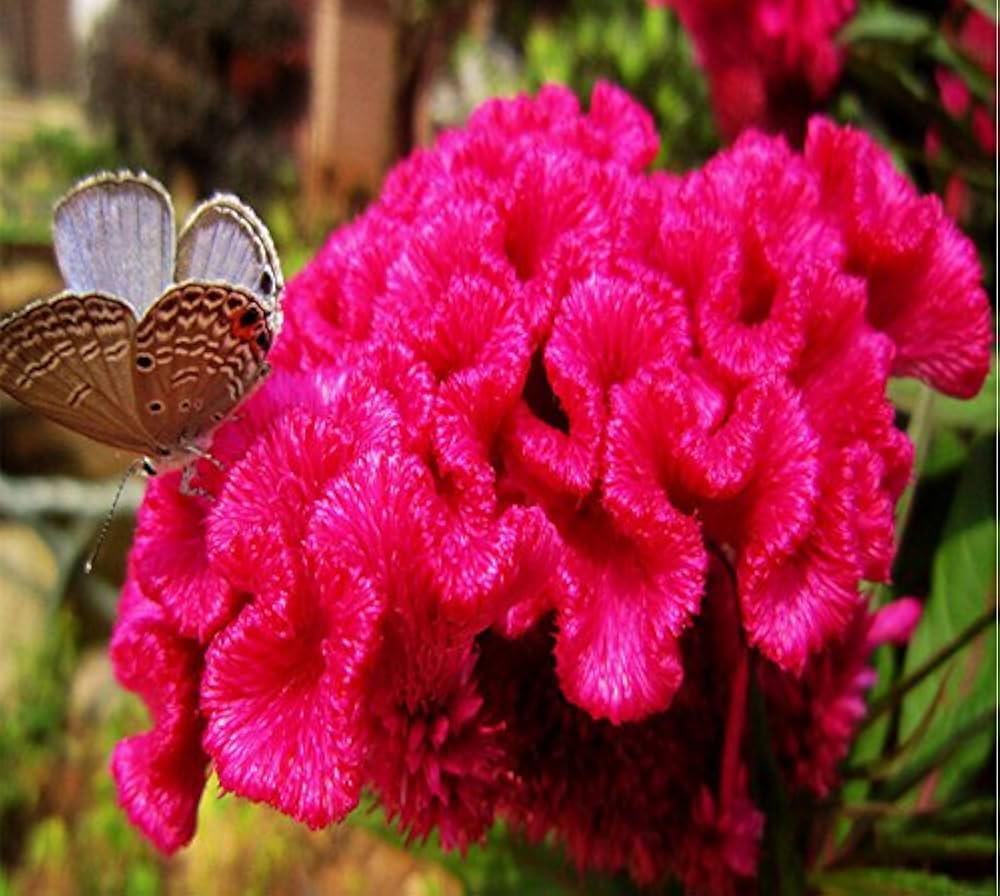
Multicolor Fuchsia Lantern Flower Indoor & Balcony Plant Seeds
Multicolor Fuchsia Lantern Flower Indoor & Balcony Plant Seeds
Fuchsia Seeds
Characteristics and Uses of Fuchsia Plants
Fuchsia plants are celebrated for their exquisite, drooping flowers that come in a stunning array of colors, making them a favorite among gardeners and floral enthusiasts alike. These non-GMO seeds yield bushy, ornamental plants that can be grown in containers or as part of garden beds. Fuchsias not only enhance the aesthetic appeal of any garden but also attract hummingbirds and butterflies, adding vibrancy and life to your outdoor space. Their flowers can be utilized in floral arrangements, while the plants themselves are perfect for shaded areas, providing a burst of color throughout the growing season.
Growing Conditions for Fuchsia Plants
- Soil Type: Well-draining, rich in organic matter.
- pH Level: Prefers a slightly acidic to neutral pH, around 6.0 to 7.0.
- Sunlight: Thrives in partial shade; too much direct sunlight can scorch the leaves.
- Temperature: Ideal temperatures range from 60°F to 70°F.
Planting Tips for Fuchsia
- Seed Depth: Sow seeds on the surface of the soil and lightly press them in.
- Spacing: Space plants about 12-18 inches apart to allow for growth.
- Timing: Start seeds indoors 8-10 weeks before the last frost date for best results.
Watering Instructions and Tips
- Frequency: Water regularly to keep the soil consistently moist but not soggy.
- Amount: Ensure the top inch of soil is dry before watering again.
- Signs of Need: Look for drooping leaves or dry soil as indicators for watering.
Growing Zones
Fuchsia plants are suitable for a variety of growing zones, including USDA zones 10-11 and global zones with similar temperate climates. This adaptability allows them to flourish in diverse environments, making them a popular choice for gardeners.
Key Benefits & Uses
- Attracts Pollinators: Fuchsias are known to attract hummingbirds and butterflies.
- Ornamental Value: Their unique flowers add beauty and color to gardens and landscapes.
- Container Gardening: Ideal for pots and hanging baskets, enhancing small spaces.
Best Uses in the Garden & Landscape
- Shaded Areas: Perfect for brightening up shady spots in the garden.
- Mixed Borders: Combines well with other flowering plants for a vibrant display.
- Hanging Baskets: Their trailing nature makes them excellent for hanging arrangements.
Conclusion
Choosing Fuchsia seeds from Dhara Seeds means investing in a high-quality, non-GMO variety that will bring beauty and life to your garden. With their stunning flowers and ability to attract pollinators, these seeds are perfect for gardeners of all levels. Dhara Seeds is a big, trusted name in the seed world, offering a wide range of high-quality, non-GMO varieties to gardeners everywhere.
FAQ
How do I grow Fuchsia?
To grow Fuchsia, start seeds indoors in a well-draining soil mix, keeping them moist and in partial shade. Once seedlings are established, transplant them outdoors after the last frost, ensuring they have adequate space and light.
When is the best time to plant Fuchsia seeds?
The best time to plant Fuchsia seeds is 8-10 weeks before the last expected frost date. This timing allows for strong seedlings that can be transplanted outdoors when conditions are favorable.
Is growing Fuchsia difficult?
Growing Fuchsia can be moderately challenging, as they require specific light and moisture conditions. However, with proper care and attention, they can thrive and reward you with beautiful blooms.
Wildflower Mix Seeds
Characteristics and Uses of Wildflower Mix Plants
Wildflower mix seeds offer a delightful assortment of native and non-native flowers that bloom in a vibrant array of colors, attracting pollinators and enhancing the beauty of any garden. This carefully curated blend is designed to thrive in various conditions, making it suitable for gardeners of all skill levels. Wildflowers not only provide aesthetic appeal but also contribute to biodiversity, support local ecosystems, and can be used in naturalized areas, meadows, and even as cut flowers in arrangements.
Growing Conditions for Wildflower Mix Plants
- Soil Type: Prefers well-draining soil with good fertility.
- pH Level: Thrives in a pH range of 6.0 to 7.5.
- Sunlight: Requires full sun to partial shade for optimal growth.
- Temperature: Best suited for moderate temperatures, typically between 60°F and 75°F.
Planting Tips for Wildflower Mix
- Seed Depth: Scatter seeds on the soil surface and lightly rake them in.
- Spacing: No need for specific spacing; a dense planting will create a natural look.
- Timing: Ideal for planting in spring or fall, depending on local climate conditions.
Watering Instructions and Tips
- Frequency: Water lightly after planting to help germination, then reduce frequency as plants establish.
- Amount: Ensure the soil remains moist but not waterlogged during the germination period.
- Signs of Need: Monitor for wilting or dry soil to determine when to water.
Growing Zones
Wildflower mix seeds are adaptable to a variety of growing zones, including USDA zones 3-10 and global zones with similar temperate climates. This versatility allows them to flourish in diverse environments, making them a popular choice for gardeners looking to enhance their outdoor spaces.
Key Benefits & Uses
- Attracts Pollinators: Supports bees, butterflies, and other beneficial insects.
- Enhances Biodiversity: Contributes to a healthy ecosystem by providing habitat and food sources.
- Low Maintenance: Once established, wildflowers require minimal care and water.
Best Uses in the Garden & Landscape
- Naturalized Areas: Perfect for creating meadows or wildflower gardens.
- Pollinator Gardens: Ideal for attracting and supporting local wildlife.
- Cut Flower Arrangements: Many wildflowers make beautiful additions to bouquets.
Conclusion
Choosing Wildflower mix seeds from Dhara Seeds means investing in a high-quality, non-GMO variety that will bring beauty and ecological benefits to your garden. With their vibrant blooms and ability to attract pollinators, these seeds are perfect for gardeners of all levels. Dhara Seeds is a big, trusted name in the seed world, offering a wide range of high-quality, non-GMO varieties to gardeners everywhere.
FAQ
How do I grow Wildflower mix seeds?
To grow Wildflower mix seeds, prepare a well-draining soil bed, scatter the seeds on the surface, and lightly rake them in. Water gently to promote germination, and ensure they receive adequate sunlight.
When is the best time to plant Wildflower mix seeds?
The best time to plant Wildflower mix seeds is in the spring or fall, depending on your local climate. This timing allows for optimal germination and growth.
Are Wildflower mixes easy to grow?
Yes, Wildflower mixes are generally easy to grow, requiring minimal maintenance once established. They thrive in various conditions and can adapt to different soil types.
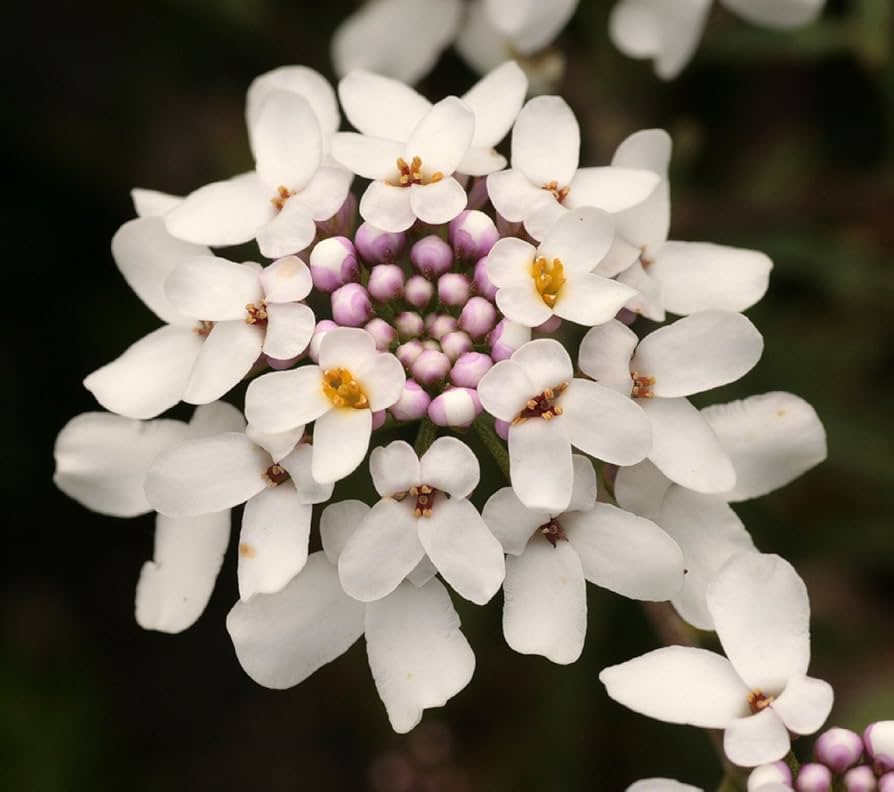
White Empress Candytuft Iberis Amara Flower Seeds
White Empress Candytuft Iberis Amara Flower Seeds
White Empress Candytuft Seeds
Characteristics and Uses of White Empress Candytuft Plants
White Empress Candytuft is a charming perennial flower known for its stunning clusters of pure white blooms that create a striking contrast against lush green foliage. This non-GMO seed variety is perfect for adding elegance to any garden, thriving in both formal and informal settings. Candytuft is often used in borders, rock gardens, and as ground cover, making it a versatile choice for gardeners looking to enhance their outdoor spaces. Its fragrant flowers are also attractive to pollinators, making it a beneficial addition to any garden ecosystem.
Growing Conditions for White Empress Candytuft Plants
- Soil Type: Prefers well-draining soil enriched with organic matter.
- pH Level: Thrives in a pH range of 6.0 to 7.5.
- Sunlight: Requires full sun for optimal growth and flowering.
- Temperature: Best suited for moderate temperatures, ideally between 60°F and 75°F.
Planting Tips for White Empress Candytuft
- Seed Depth: Sow seeds ¼ inch deep in the soil.
- Spacing: Space plants 12-15 inches apart to allow for proper growth.
- Timing: Ideal for planting in early spring or fall, depending on local climate conditions.
Watering Instructions and Tips
- Frequency: Water regularly, especially during dry spells, to keep the soil consistently moist.
- Amount: Ensure the soil is well-drained to prevent waterlogging.
- Signs of Need: Monitor for wilting leaves or dry soil to determine when to water.
Growing Zones
White Empress Candytuft is suitable for a variety of growing zones, including USDA zones 3-9 and global zones with similar temperate climates. This adaptability allows it to flourish in diverse environments, making it a popular choice for gardeners.
Key Benefits & Uses
- Attracts Pollinators: The fragrant flowers draw in bees and butterflies.
- Low Maintenance: Once established, Candytuft requires minimal care.
- Versatile Use: Ideal for borders, rock gardens, and as ground cover.
Best Uses in the Garden & Landscape
- Flower Borders: Adds a beautiful edge to garden beds.
- Rock Gardens: Complements rocky landscapes with its delicate blooms.
- Ground Cover: Provides a lush carpet of flowers that suppresses weeds.
Conclusion
Choosing White Empress Candytuft seeds from Dhara Seeds means investing in a high-quality, non-GMO variety that will enhance the beauty and biodiversity of your garden. With its elegant blooms and ability to attract pollinators, this plant is perfect for gardeners of all levels. Dhara Seeds is a big, trusted name in the seed world, offering a wide range of high-quality, non-GMO varieties to gardeners everywhere.
FAQ
How do I grow White Empress Candytuft?
To grow White Empress Candytuft, prepare a well-draining soil bed, sow seeds ¼ inch deep, and ensure they receive full sun. Water regularly to keep the soil moist until the plants are established.
When is the best time to plant White Empress Candytuft seeds?
The best time to plant White Empress Candytuft seeds is in early spring or fall, depending on your local climate. This timing allows for optimal germination and growth.
Is growing White Empress Candytuft difficult?
Growing White Empress Candytuft is relatively easy, making it suitable for gardeners of all experience levels. With proper care and attention, these plants can thrive and reward you with beautiful blooms.
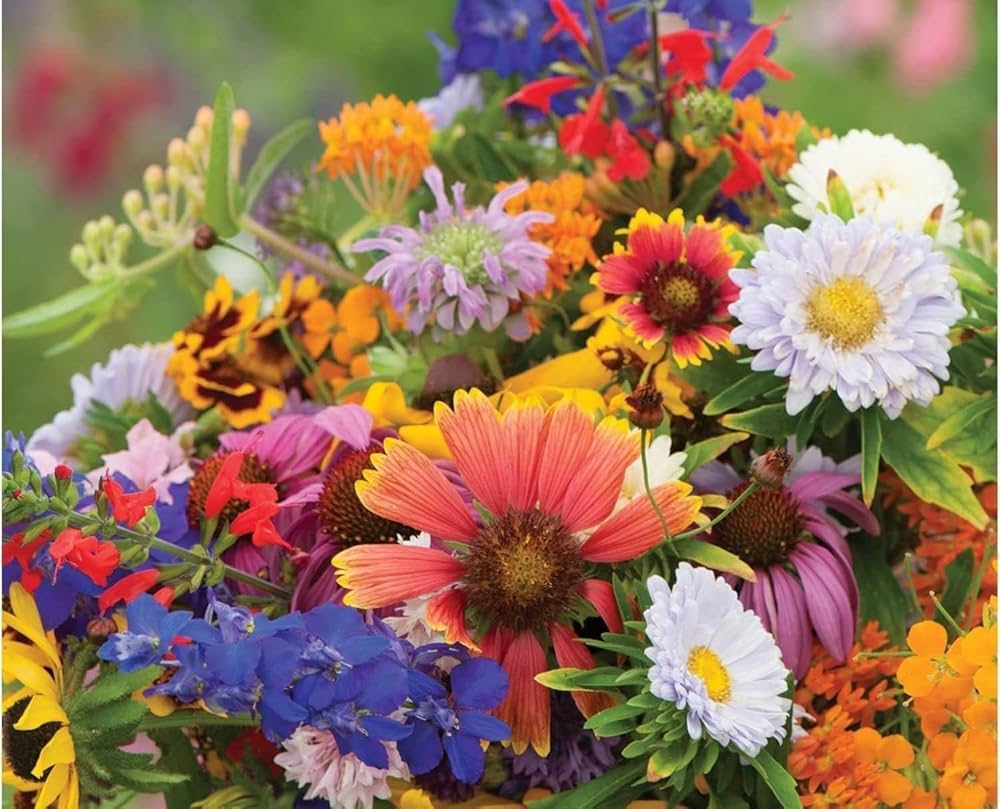
Wahpe Washtemna Native Wildflower Perennial Seeds
Wahpe Washtemna Native Wildflower Perennial Seeds
Wahpe Washtemna Wildflower Seeds
Characteristics and Uses of Wahpe Washtemna Wildflower Plants
Wahpe Washtemna, also known as the "White Buffalo Clover," is a striking wildflower that features delicate white blooms and lush green foliage. This non-GMO seed variety is not only visually appealing but also plays a crucial role in supporting local ecosystems by attracting essential pollinators such as bees and butterflies. Ideal for creating naturalized gardens, meadows, or mixed borders, Wahpe Washtemna enhances biodiversity and adds beauty to any outdoor space, making it a perfect choice for gardeners of all levels.
Growing Conditions for Wahpe Washtemna Wildflower Plants
- Soil Type: Prefers well-draining soil that is rich in organic matter.
- pH Level: Thrives in a pH range of 6.0 to 7.5.
- Sunlight: Requires full sun to partial shade for optimal growth.
- Temperature: Best suited for moderate temperatures, ideally between 60°F and 75°F.
Planting Tips for Wahpe Washtemna Wildflower
- Seed Depth: Sow seeds on the surface of the soil and lightly press them in.
- Spacing: Space seeds about 12 inches apart to allow for natural growth.
- Timing: Ideal for planting in spring or fall, depending on local climate conditions.
Watering Instructions and Tips
- Frequency: Water lightly after planting to aid germination, then reduce frequency as plants establish.
- Amount: Ensure the soil remains moist but not waterlogged during the germination period.
- Signs of Need: Monitor for wilting or dry soil to determine when to water.
Growing Zones
Wahpe Washtemna Wildflower seeds are suitable for a variety of growing zones, including USDA zones 3-9 and global zones with similar temperate climates. This adaptability allows them to flourish in diverse environments, making them a popular choice for gardeners looking to enhance their outdoor spaces.
Key Benefits & Uses
- Attracts Pollinators: Supports bees, butterflies, and other beneficial insects.
- Enhances Biodiversity: Contributes to a healthy ecosystem by providing habitat and food sources.
- Low Maintenance: Once established, Wahpe Washtemna requires minimal care and water.
Best Uses in the Garden & Landscape
- Naturalized Areas: Perfect for creating meadows or wildflower gardens.
- Pollinator Gardens: Ideal for attracting and supporting local wildlife.
- Cut Flower Arrangements: Many wildflowers make beautiful additions to bouquets.
Conclusion
Choosing Wahpe Washtemna Wildflower seeds from Dhara Seeds means investing in a high-quality, non-GMO variety that will bring beauty and ecological benefits to your garden. With its delicate blooms and ability to attract pollinators, this wildflower is perfect for gardeners of all levels. Dhara Seeds is a big, trusted name in the seed world, offering a wide range of high-quality, non-GMO varieties to gardeners everywhere.
FAQ
How do I grow Wahpe Washtemna Wildflower seeds?
To grow Wahpe Washtemna Wildflower seeds, prepare a well-draining soil bed, scatter the seeds on the surface, and lightly press them in. Water gently to promote germination, and ensure they receive adequate sunlight.
When is the best time to plant Wahpe Washtemna Wildflower seeds?
The best time to plant Wahpe Washtemna Wildflower seeds is in the spring or fall, depending on your local climate. This timing allows for optimal germination and growth.
Are Wahpe Washtemna Wildflowers easy to grow?
Yes, Wahpe Washtemna Wildflowers are generally easy to grow, requiring minimal maintenance once established. They thrive in various conditions and can adapt to
Turkish Poppy Mix Seeds
Characteristics and Uses of Turkish Poppy Mix Plants
The Turkish Poppy Mix is a vibrant blend of stunning poppy varieties, known for their large, colorful blooms that range from deep reds to soft pinks and whites. These non-GMO seeds produce elegant flowers that not only enhance the beauty of any garden but also attract pollinators such as bees and butterflies. Ideal for creating eye-catching borders, wildflower gardens, or as cut flowers for arrangements, the Turkish Poppy Mix is a delightful choice for gardeners seeking to add a splash of color and charm to their outdoor spaces.
Growing Conditions for Turkish Poppy Mix Plants
- Soil Type: Prefers well-draining soil that is moderately fertile.
- pH Level: Thrives in a pH range of 6.0 to 7.5.
- Sunlight: Requires full sun for optimal growth and flowering.
- Temperature: Best suited for cooler temperatures, ideally between 55°F and 70°F.
Planting Tips for Turkish Poppy Mix
- Seed Depth: Sow seeds on the surface of the soil and lightly press them in, as they require light for germination.
- Spacing: Space seeds about 12 inches apart to allow for proper growth.
- Timing: Ideal for planting in early spring or fall, depending on local climate conditions.
Watering Instructions and Tips
- Frequency: Water lightly after planting to aid germination, then reduce frequency as plants establish.
- Amount: Ensure the soil remains moist but not waterlogged during the germination period.
- Signs of Need: Monitor for wilting or dry soil to determine when to water.
Growing Zones
The Turkish Poppy Mix is suitable for a variety of growing zones, including USDA zones 3-9 and global zones with similar temperate climates. This adaptability allows them to flourish in diverse environments, making them a popular choice for gardeners looking to enhance their outdoor spaces.
Key Benefits & Uses
- Attracts Pollinators: Supports bees, butterflies, and other beneficial insects.
- Low Maintenance: Once established, Turkish poppies require minimal care.
- Versatile Use: Perfect for borders, wildflower gardens, and cut flower arrangements.
Best Uses in the Garden & Landscape
- Flower Borders: Adds vibrant color and texture to garden edges.
- Wildflower Gardens: Creates a natural and beautiful meadow effect.
- Cut Flower Arrangements: Ideal for bringing a touch of elegance indoors.
Conclusion
Choosing Turkish Poppy Mix seeds from Dhara Seeds means investing in a high-quality, non-GMO variety that will bring beauty and ecological benefits to your garden. With their stunning blooms and ability to attract pollinators, these seeds are perfect for gardeners of all levels. Dhara Seeds is a big, trusted name in the seed world, offering a wide range of high-quality, non-GMO varieties to gardeners everywhere.
FAQ
How do I grow Turkish Poppy Mix seeds?
To grow Turkish Poppy Mix seeds, prepare a well-draining soil bed, scatter the seeds on the surface, and lightly press them in. Water gently to promote germination, and ensure they receive adequate sunlight.
When is the best time to plant Turkish Poppy Mix seeds?
The best time to plant Turkish Poppy Mix seeds is in early spring or fall, depending on your local climate. This timing allows for optimal germination and growth.
Are Turkish Poppies easy to grow?
Yes, Turkish Poppies are generally easy to grow, requiring minimal maintenance once established. They thrive in various conditions and can adapt to different soil types.
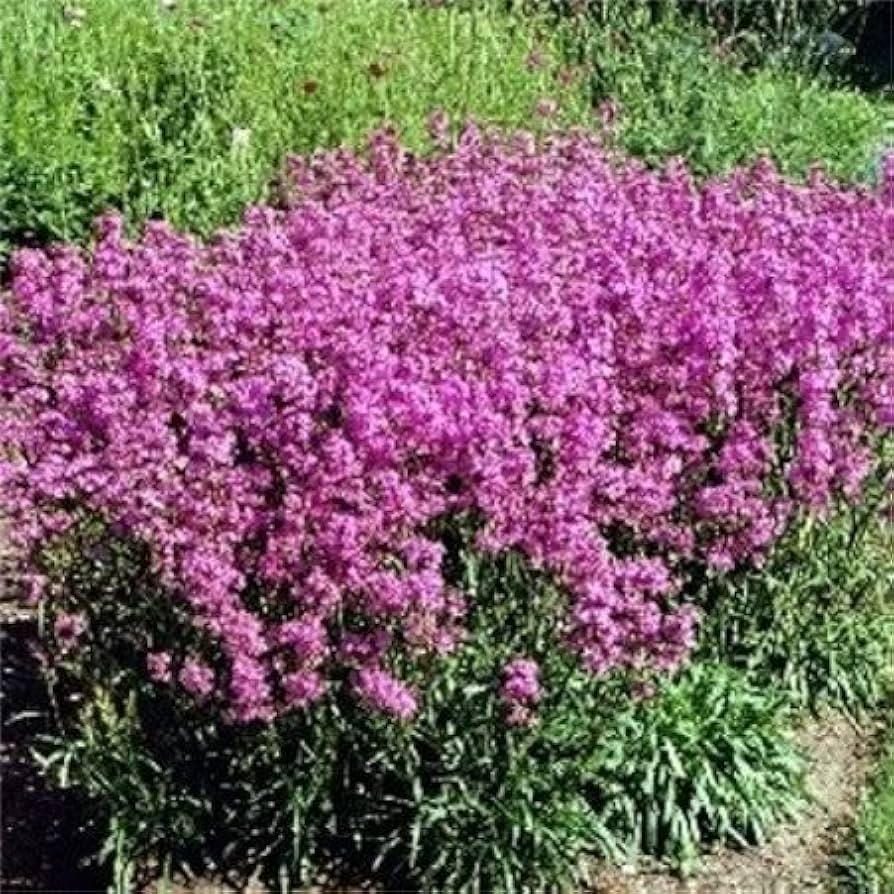
Tall Pink Campion Silene Armeria Wildflower Seeds
Tall Pink Campion Silene Armeria Wildflower Seeds
Tall Pink Campion Seeds
Characteristics and Uses of Tall Pink Campion Plants
Tall Pink Campion, known for its striking pink flowers and tall, slender stems, is a delightful addition to any garden. This non-GMO seed variety produces vibrant blooms that can reach heights of up to 3 feet, making them perfect for adding vertical interest to flower beds and borders. The flowers are not only visually appealing but also attract pollinators such as bees and butterflies, enhancing the biodiversity of your garden. Tall Pink Campion is ideal for cottage gardens, wildflower meadows, and as a cut flower in arrangements, making it a versatile choice for gardeners of all levels.
Growing Conditions for Tall Pink Campion Plants
- Soil Type: Prefers well-draining, fertile soil enriched with organic matter.
- pH Level: Thrives in a pH range of 6.0 to 7.5.
- Sunlight: Requires full sun to partial shade for optimal growth.
- Temperature: Best suited for moderate temperatures, ideally between 60°F and 75°F.
Planting Tips for Tall Pink Campion
- Seed Depth: Sow seeds ¼ inch deep in the soil.
- Spacing: Space plants about 12-18 inches apart to allow for proper growth.
- Timing: Ideal for planting in early spring or fall, depending on local climate conditions.
Watering Instructions and Tips
- Frequency: Water regularly to keep the soil consistently moist but not soggy.
- Amount: Aim for about 1 inch of water per week, adjusting for rainfall.
- Signs of Need: Look for wilting leaves or dry soil as indicators for watering.
Growing Zones
Tall Pink Campion is suitable for a variety of growing zones, including USDA zones 3-9 and global zones with similar temperate climates. This adaptability allows it to flourish in diverse environments, making it a popular choice for gardeners looking to enhance their outdoor spaces.
Key Benefits & Uses
- Attracts Pollinators: Supports bees, butterflies, and other beneficial insects.
- Low Maintenance: Once established, Tall Pink Campion requires minimal care.
- Versatile Use: Perfect for borders, wildflower gardens, and cut flower arrangements.
Best Uses in the Garden & Landscape
- Flower Borders: Adds vibrant color and height to garden edges.
- Wildflower Gardens: Creates a natural and beautiful meadow effect.
- Cut Flower Arrangements: Ideal for bringing a touch of elegance indoors.
Conclusion
Choosing Tall Pink Campion seeds from Dhara Seeds means investing in a high-quality, non-GMO variety that will bring beauty and ecological benefits to your garden. With their stunning blooms and ability to attract pollinators, these seeds are perfect for gardeners of all levels. Dhara Seeds is a big, trusted name in the seed world, offering a wide range of high-quality, non-GMO varieties to gardeners everywhere.
FAQ
How do I grow Tall Pink Campion seeds?
To grow Tall Pink Campion seeds, prepare a well-draining soil bed, sow seeds ¼ inch deep, and ensure they receive full sun to partial shade. Water regularly to keep the soil moist until the plants are established.
When is the best time to plant Tall Pink Campion seeds?
The best time to plant Tall Pink Campion seeds is in early spring or fall, depending on your local climate. This timing allows for optimal germination and growth.
Are Tall Pink Campion flowers easy to grow?
Yes, Tall Pink Campion flowers are generally easy to grow, requiring minimal maintenance once established. They thrive in various conditions and can adapt to different soil types.






